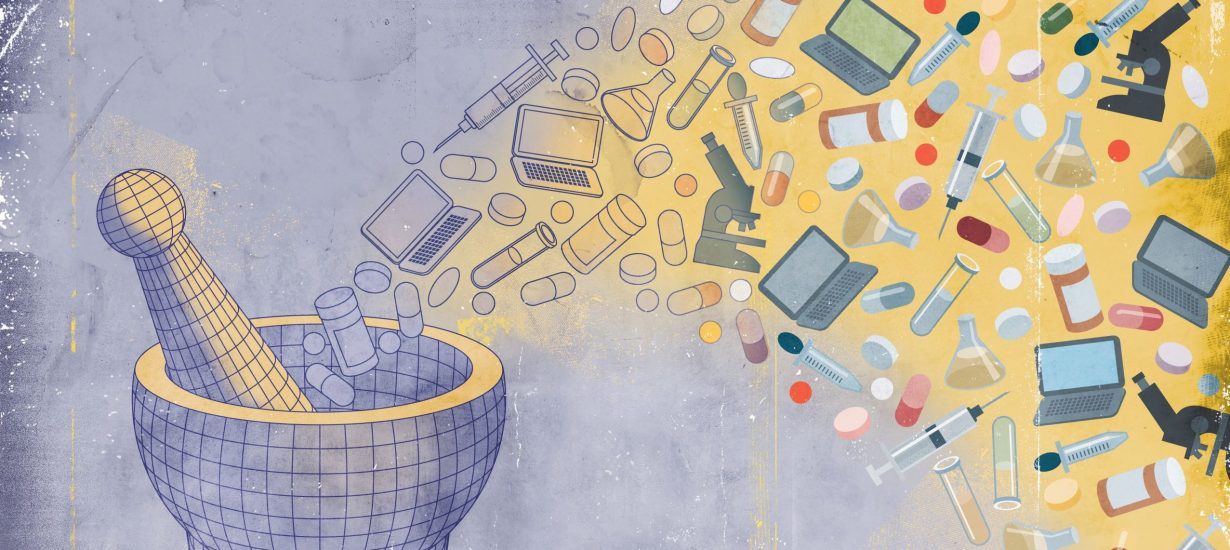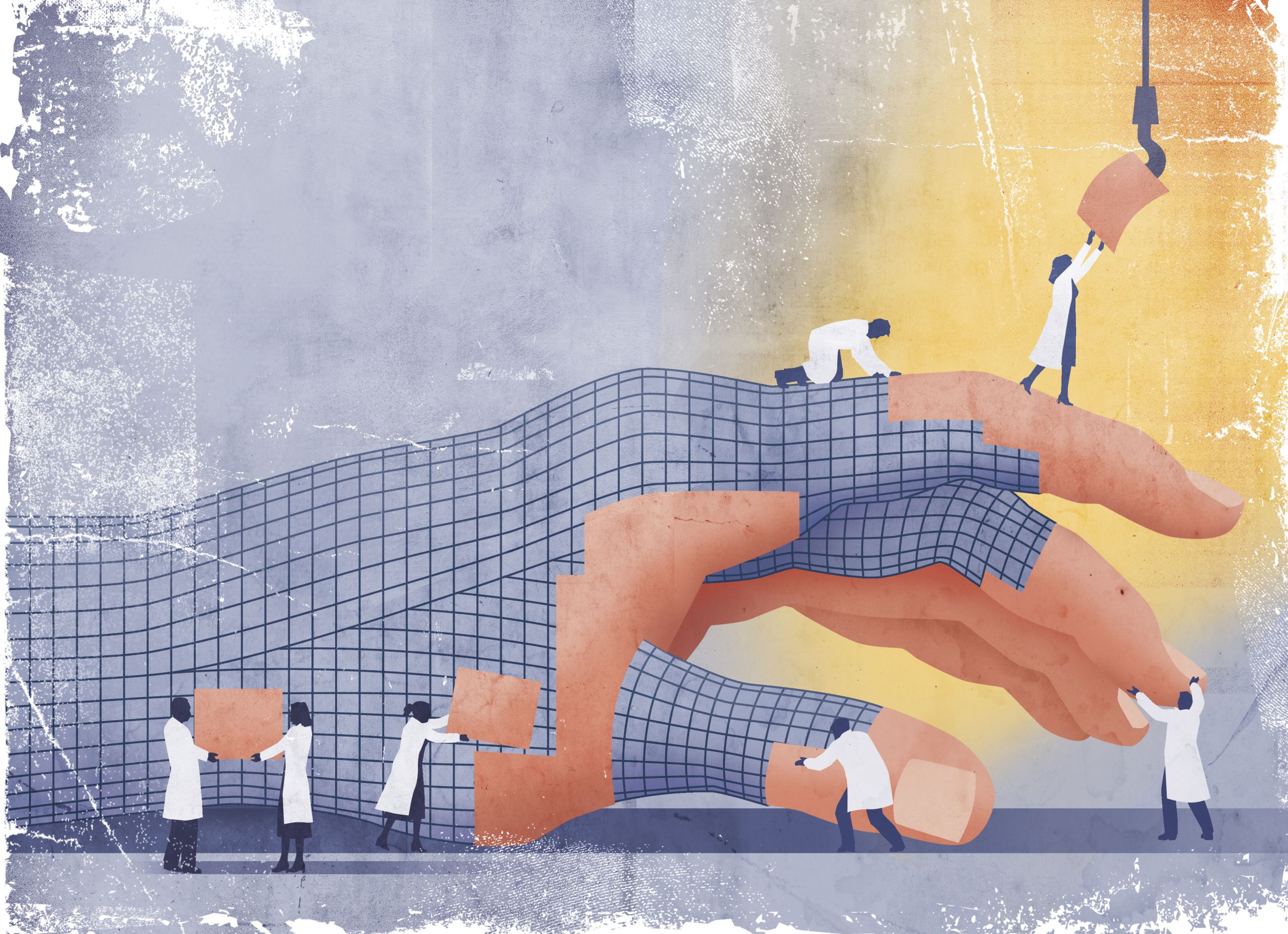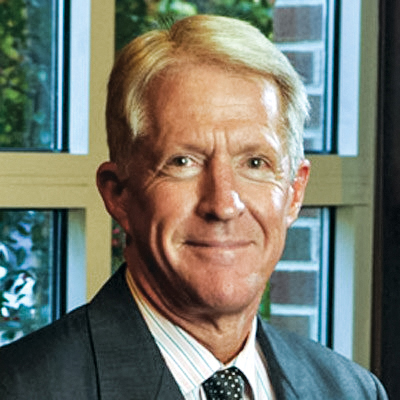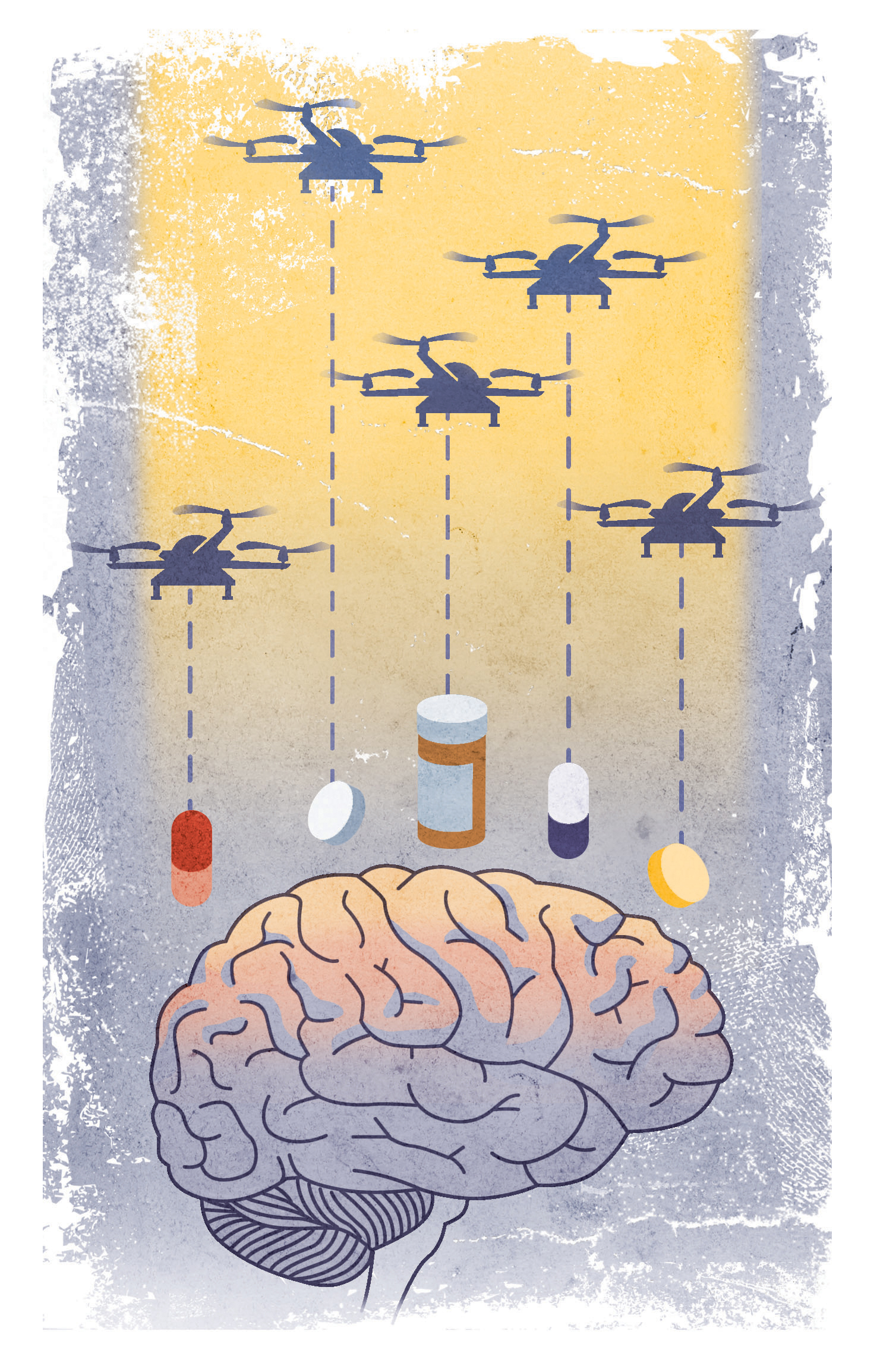100 Million Ways to Succeed

An extraordinary gift carries an eagerly embraced obligation to shape the future of pharmacology teaching and research.
by Scott Huler
In a cubicle in a carpeted room at the end of a hallway that could be in any building anywhere, Steve Sickles brings up the future of the pharmacy profession on a computer screen. It’s a body, though that may be an exaggeration: It’s little more than a wireframe image now — a torso, with its left arm extended. It’s purple.
Jerry Heneghan explains, looking over Sickles’ shoulder.
“He’s actually starting to work on the first virtual patient,” says Heneghan, professor of the practice at UNC’s Eshelman School of Pharmacy. This office isn’t in some Research Triangle Park mega- campus or downtown Durham computer game startup. It’s on campus in Beard Hall. Heneghan is director of the pharmacy school’s new Center for Innovation in Pharmacy Simulation, and before long that purple torso will have skin and vital signs and the capacity to model literally decades of response to medication and treatment.
“We’re creating a virtual patient in a way that’s never been done before.”
A virtual patient is a mathematical model of a person in the same way a flight simulator is a mathematical model of an aircraft. That flight simulator gives pilots the chance to try lots and lots of things under lots and lots of circumstances before they get to fly in the air and absolutely have to get everything right. Similarly, virtual patients enable health care providers — in this case, pharmacists — to try lots of different things, experience lots of different patient and drug interactions before they’re helping real patients in real situations with real medication protocols. And real results.
Heneghan estimates that a graduate of the school leaves with 40 or 50 patient experiences, whether through simulations or work with mannequins or actors trained to portray patients with specific symptoms and problems.
“What if that number was 250?” Heneghan asks, his voice rising. “Or 300? Through iterative, repeatable, dynamic situations that change, right? To really stretch the application of foundational knowledge and also provide a lot more variables.
“You put students in the hardest, most difficult and most culturally accurate situations that they may be exposed to. So that when they are out in the world they have a scaffolding to fall back on. They say, ‘That isn’t so hard. I had to do something like this in simulator scenario number 25.’ ”
Tying that mathematical representation of the body to recommended drug therapy — things like drug-on-drug interactions — puts pharmacists in some seemingly no-win situations.
Change in health care delivery is accelerating, necessitating a new practice model for pharmacists. Drug therapy is one of the focal points of that change. The Affordable Care Act has upped the ante.
In the top-ranked pharmacy school in the nation, the image of kindly people in white coats standing in a drugstore counting pills is an obsolete reality. UNC pharmacy students and researchers now are splendidly positioned to shape change. Fred Eshelman ’72 made sure of that.
Eshelman’s gift of $100 million to the school two years ago — the largest-ever single donation to Carolina — is designed to free researchers to try something weird that might find a brand-new drug rather than chase National Institutes of Health funding for an incremental advance; Eshelman designed the gift as almost the exact opposite of common large gifts to universities, which create endowments, tying up cash in investments that provide regular, if unspectacular, yields.
“What [the] gift really meant for us was speed,” said Shawn Hingtgen, a clinical assistant professor. “The lab got a $750,000 award in the first round of funding the gift generated.” It’s hard to pry grant money for preclinical development before a new approach is proven: “The Eshelman is filling these gaps for us.”

(Illustration by Sam Ward)
A transformed model
Hingtgen’s lab is pursuing ways to use patient skin to create stem cells — which have the property of naturally crawling toward tumors — and then arm those cells with anticancer drugs and use them to aggressively treat brain cancers.
“Our therapy,” Hingtgen said, “will be to create little tumor-homing, stem cell drug pumps.”
These are tiny cells that, like the tiny submarine in Fantastic Voyage, make their way into the patient’s brain to solve a problem, only instead of bringing Raquel Welch, Hingtgen’s bring anticancer agents.
These cells are the newest advance on the skin-to-stem-cell process, discovered at Harvard and awarded a Nobel Prize in 2012. Hingtgen’s lab is the first to have tested the therapy on mice, and it worked.

‘Why would someone give $100 million to a school of pharmacy, based on whatever their stereotypical understanding was of what a pharmacy school taught?’ Dean Bob Blouin
Bob Blouin, dean of the school since arriving at UNC in 2003, recognizes that “there were a lot of people scratching their heads” when Eshelman made the largest-ever private gift to any school of pharmacy. “Why would someone give $100 million to a school of pharmacy, based on whatever their stereotypical understanding was of what a pharmacy school taught?”
Blouin had spent a decade laying the groundwork for being noticed. Shortly after he came to Carolina, he was asked to speak to UNC’s trustees about his vision for the school. He looked around at the people in the room, turned back to the trustees and said: “Do you know what my greatest challenge is as the dean of the School of Pharmacy? You don’t expect enough out of our school. Our school can do so much more to help this University to become the number one public university in the country, if only you would invest in us.”
Two weeks later, the vice chancellor for facilities called and told him the trustees thought maybe he did need more. He offered Blouin a floor in the new Genetic Medicine Building. Blouin said he’d take two. He wound up getting one and two-thirds. That space enabled the school to hire about 20 faculty members who, Blouin said, “transformed our school scientifically.”
During Blouin’s 13 years, pharmacy’s research funding has grown 1,500 percent. The school has nearly doubled both its faculty and its graduate student ranks in a profession that faces overwhelming change.
As health care continues to move away from a fee-for-service model and toward a model that pays for value-add — think of the shift to HMOs — the school is looking for answers: What ought pharmacists to be doing with their time? How do they get paid for that work? How do they make the greatest contribution to patient health in the new health care ecosystem, in which doctors, nurses, pharmacists and others work as a team? How do they find the next drugs that contribute to patient health?
“If you look at the percentages of the number of people who are readmitted to the hospital and track what the origin is for the basis of that readmission,” Blouin said shortly after the Eshelman gift was announced, “it often has the patient either noncompliant, they were on the wrong drug, on the wrong dose, had a drug-drug interaction, had a genetic drug interaction or had a physiologic drug interaction. Almost 50 to 60 percent of the hospital readmissions are drug-related.
“If you’re going to need a new kind of health care provider functioning within that transformed model, you’re going to have to have an educational process that will prepare the student to enter that transformed model.”
The school has been working on that transformation since 2012, and “we now find ourselves uniquely at this intersection of practice transformation and curricular transformation,” Blouin said. “We started with, ‘What will society need in 2025?’ And then said, ‘Let’s reverse engineer our education program to provide that.’ ”
The gift of confidence

‘You’re betting on people. I knew the right people were in place here. You never quit a winner —
you keep investing.’ Fred Eshelman ’72
In 1985, Fred Eshelman founded the drug development lab PPD. It became a world leader, generating billions when it was sold and enabling Eshelman to donate a lot of money where he thought it could do good. His previous investments in the school — $30 million over the past decade — have supported scholarships and faculty research, cancer research, advances in pharmacy practice and education, and a new drug discovery center. They fostered a sense that it was on the cutting edge, reframing the practice of pharmacy as a dramatically changing health care environment required.
To Eshelman, that didn’t seem to be the time to throttle back. “You’re betting on people,” he told Forbes magazine at the time of his gift. “I knew the right people were in place here. You never quit a winner — you keep investing.”
At a time when the state of North Carolina was reducing its investment in its state universities, Eshelman renewed his support. Blouin recalls him saying: “The first gift I gave was a gift of hope. The gift I am giving to you now is a gift of confidence.”
Eshelman’s gift created the Eshelman Institute for Innovation, whose goal is to create change — not just in new drugs but in new areas of research and new ways to share research; not just new educational approaches but in gathering and assessing results on those approaches.
To date, the institute has sponsored two rounds of funding, giving gifts of four tiers, from up to $50,000 to up to $2 million — one in 2015 created the simulation center and brought in Heneghan and other new people from across the gaming and simulations world.
“Basically, he said, ‘Take this gift and make a big impact on society and health care,’ ” said Dhiren Thakker, associate dean for entrepreneurial development. Thakker works with professors doing research, helping them get the support they need to turn the products of their research into companies, patents, products and revenue.
The culture of entrepreneurship has been developing in the Eshelman School for the past five years, Thakker said, resulting in more than a dozen spinoff companies in different stages of development.
One example is Qualyst, a company Thakker founded in 2003 with two other UNC faculty members, Associate Dean Kim Brouwer and adjunct Gary Pollack. Qualyst provides liver drug transporter products and conducts contract research. Another example is Panacise Bio, founded last year by Associate Professor Rihe Liu to work with self-assembling protein multimers. Multimers — molecules held together by less-strong bonds than, say, polymers — have characteristics that make them useful for diagnosis and therapy. Another startup is Meryx, founded by faculty members Stephen Frye ’87 (PhD) and Shelley Earp ’70 (MD, ’72 MS) in 2013 to provide oral drugs that inhibit tumor growth and initiate antitumor immunity.
“It’s just created a huge opportunity for people to be entrepreneurial,” Frye said, “to think of innovative ideas, and think there’s a funding method not like the traditional NIH study section reviews. It gives us a source of funding for really novel and high-risk projects.”

The money is showing results, from spinning out new companies to creating tiny little boxes that deliver drugs to the exact spot they’re needed, like a drone with a FedEx package. (Image by Sam Ward)
A player among the best
That commitment to drug discovery and development and the basic research behind it has improved the school’s national and international reputation, Thakker said, to the degree that it was sought out by the Structural Genomics Consortium, a conglomeration of academic and pharmaceutical partners in Canada, the United Kingdom, Brazil and other countries.
Foundational to the SGC model is that its results are open source and available for use not only by their developers but by any subsequent users who hope to advance the research or create products based on that research. As a result, the universities — Oxford, the University of Toronto, now UNC and others — do the kind of basic research that addresses the possible genomic causes of degenerative diseases and cancer.
This is big-idea research, which is hard to fund. The universities hope they can create pharmaceuticals to license from that research. But so can other companies or universities or researchers. Part of the point of developing drugs is to license them and create revenue, but more foundational to drug research is the goal of solving medical problems and advancing science.
Thakker gives an example: Enzymes called kinases function as switches controlling many cellular operations, presenting a target-rich area for the development of drugs that might interact with and control those kinases. But at the moment, these kinases present no specific solutions for identified problems, making research hard to fund through the usual sources.
Do basic research into kinases, and you might find a way they can be used to solve an existing medical problem. Better yet, as your open-source research spreads, people around the world can advance it further — perhaps including an underfunded research lab where a scientist notices something, says, “Hold on,” and then uses kinase controls to solve a worldwide problem.
So when the invitation from the genomics consortium came, the Eshelman School wanted to play.
“The idea is if you make it open source, a lot of other places pick up this knowledge and develop drugs,” Thakker said. “This is an investment. This would catalyze drug discovery that would never have happened without this gift.”
Similar resource sharing occurs with the Genetic Alliance, a group of 1,200 nonprofits advocating for the sufferers of rare diseases that commonly affect no more than 5,000 patients or so worldwide.
“Pharma companies are not going to develop drugs when there’s 5,000 patients,” Thakker said. Through the Genetic Alliance, the school is part of Catalyst, an entity that brings in scientists to pursue some of these neglected diseases by systematically exploring chemical probes — and again, the results are open source. The alliance also supports postdocs or young scientists with interests in specific diseases, which can speed progress toward cure.
Everything the Eshelman Institute for Innovation does is meant to have a multiplicative effect. Open source results share ideas, improving the science and practice of pharmacy, and branding the school as a thought leader generating open-source research. Understanding the changing health care environment and designing a curriculum to prepare students to thrive in that ecosystem makes for better pharmacists.
Mary McClurg, the school’s associate director for academic innovation, likes to cite the statistic that “for every dollar we spend on prescription medications, we spend a dollar trying to resolve a problem related to medication” — medication misprescribed, misapplied or otherwise incorrectly used. “It’s like a $300 billion problem with respect to misadventures around medication use.” Which is $300 billion worth of opportunities to find improvements.
Someone needs to step up and fill the hole left by too-busy physicians, an ill-fitting and still undeveloped payment scheme, and an uncertain future, Blouin said. “Pharmacists — highly skilled clinician-practitioners with a deep and broad understanding of drugs and drug action — would be the best health care professional to do it.”
Two years ago, Fred Eshelman placed a $100 million bet that the best place for all those transformational needs to be met was UNC’s pharmacy school.
The money is showing results. It’s turning normal skin cells into tumor-homing stem cell drug pumps. It’s redesigning the way pharmacists are educated, and it’s gathering data on what works so the redesign never stops. It’s creating virtual patients that allow health care team members to train in almost unimaginable new ways. It’s spinning out new companies, joining international consortia and creating tiny little boxes that deliver drugs to the exact spot they’re needed, like a drone with a FedEx package.
As of last April, the school has all that accrues from U.S. News & World Report’s No. 1 ranking nationally. More importantly, the gift has freed researchers to take another flying leap.
Bob Blouin found himself at a national meeting about a week after the Eshelman announcement in December 2014. “Many of my colleagues came up to me and said something that I was not expecting. They said, ‘Thank you.’ I asked, ‘For what?’ They said that this gift has not only helped to instill confidence in your school and your university, it is a gift of confidence for our profession, and it has elevated all of our games at all of our universities.”
Scott Huler, based in Raleigh, has written a wide range of nonfiction, both in North Carolina and elsewhere; taught creative writing at Carolina; and recently joined Duke Magazine as its senior writer.
Thanks for reading the Carolina Alumni Review
Carolina Alumni members, sign in to continue reading.
Not yet a member? Become one today.
